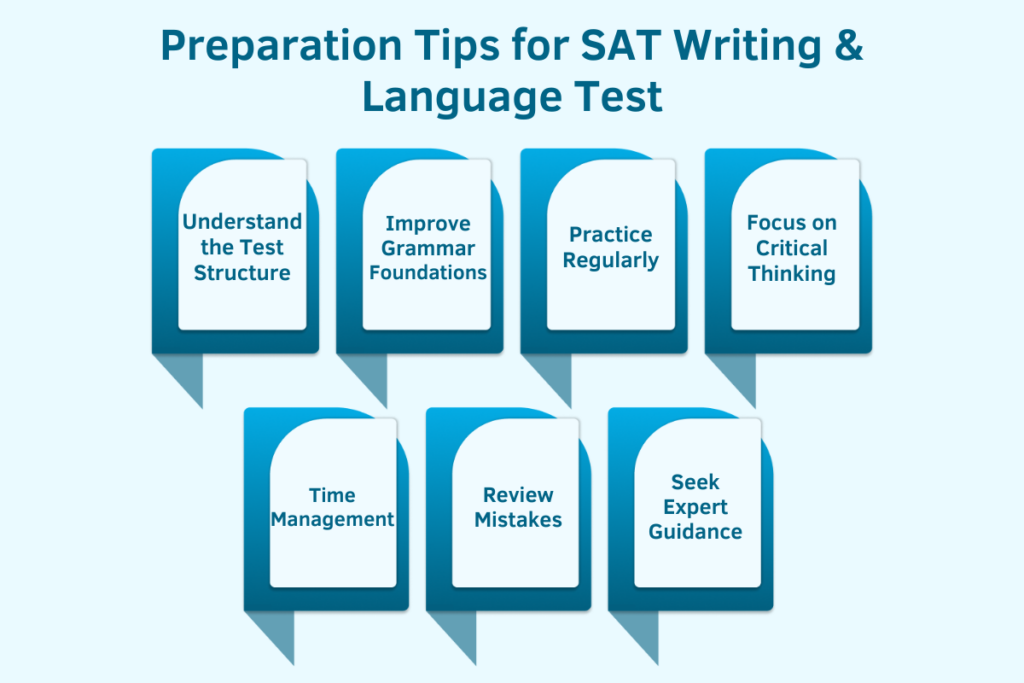The scholastic aptitude test writing & language stands as a significant hurdle for Indian students who are aiming to pursue higher education abroad. With over 25,000 Indian students taking the SAT annually, you can understand that the competition is fierce.
A strong performance in this section is essential for a competitive college application. It showcases your proficiency in English and your readiness for the academic challenges of college.
This comprehensive guide will serve as your roadmap to navigating this challenging terrain. You will learn every aspect of the scholastic aptitude test writing & language, including the syllabus, question types, essential skills, effective preparation strategies, and more. Read on!
Overview of SAT Writing & Language Test
If you are aiming to study abroad, the scholastic aptitude test writing & language is a crucial section. With a duration of 35 minutes and a total of 44 multiple-choice questions, this section will assess your ability to improve and refine written passages.
This test covers many topics, such as careers, history, science, and social studies, making it essential to have a broad understanding of various subjects.
Here is a quick overview of the scholastic aptitude test writing & language.
| Aspect | Details |
|---|---|
| Test Duration | 35 minutes |
| Number of Questions | 44 |
| Number of Passages | 4 (each 400–450 words) |
| Question Format | Multiple-choice |
| Topics Covered | CareersHistoryScienceSocial Studies |
Also Read: SAT Exam Registration 2025
SAT Writing and Language Syllabus
The syllabus for the scholastic aptitude test writing & language is designed to test your grasp of standard English conventions and your ability to edit and improve written material. Additionally, rhetorical analysis is key in improving clarity and style, especially in constructing a well-organised SAT test essay.
Mastering these areas will prepare you for both the Writing & Language section and the SAT test essay. The questions focus on a mix of grammatical rules, sentence structure, and logical flow.
Here is a quick overview table of the SAT writing & language syllabus.
| Category | Description |
|---|---|
| Standard English Conventions | Grammar Punctuation Sentence structure rules |
| Expression of Ideas | Improving clarity Organisation Logical flow in passages. |
| Command of Evidence | Choosing evidence to support arguments and claims. |
| Words in Context | Understanding how word choice impacts tone, style, and meaning. |
| History/Social Studies & Science | Editing and analysing passages related to specialised topics in these domains. |
What Are the SAT Writing Passages Like?
The scholastic aptitude test writing & language section has passages that reflect diverse real-world contexts. The questions will require you to improve the text, correct errors, and analyse the intent behind the writing.
These passages often include a variety of formats, such as informational texts, arguments, and narratives, including SAT test essays, offering a wide variety of challenges to keep you engaged and test your adaptability.
Here are some examples of SAT questions.
| Question Type | Example of SAT Questions |
|---|---|
| Sentence Combination | “Which choice most effectively combines the sentences?” |
| Grammar Correction | “Which version of the underlined part is correct?” |
| Improving Logic | “Which sentence best completes the argument in the paragraph?” |
| Word Choice | “Which option best maintains the tone and style of the passage?” |
Skills Tested by SAT Writing and Language
The scholastic aptitude test writing & language evaluates a diverse set of skills essential for effective written communication. A strong foundation in Standard English Conventions is crucial, encompassing grammar, punctuation, and sentence structure.
Skills Required for Scholastic Aptitude Test Writing & Language
You’ll be assessed on your ability to identify and correct errors in these areas, ensuring your writing adheres to the rules of standard written English.
To excel in the scholastic aptitude test writing & language, it’s important to master a set of skills that focus on editing, analysing, and improving the text. Here is a quick overview.
| Skill Area | Importance |
|---|---|
| Grammar and Usage | Identifying and correcting errors in sentence structure and punctuation. |
| Editing for Clarity | Ensuring sentences are concise, coherent, and free of redundancy. |
| Logical Analysis | Analysing paragraph structure and suggesting logical improvements. |
| Time Management | Answering 44 questions in 35 minutes requires effective pacing. |
| Critical Thinking | Understanding tone and style to choose revisions that align with the passage’s intent. |
SAT Writing and Language Books
The right study materials can dramatically improve your preparation outcomes. Several trusted books are available to help you understand the test format, practice questions, and refine your strategies.
Here are some of the major recommended books for scholastic aptitude test writing & language preparation.
| Book Name | Author/Publisher | Features |
|---|---|---|
| The Official SAT Study Guide | College Board | Authentic practice questions and test insights. |
| Barron’s SAT Writing Workbook | Barron’s Publishing | Focused exercises for grammar and writing skills. |
| The Ultimate Guide to SAT Grammar | Erica L. Meltzer | Comprehensive grammar explanations and practice. |
| Kaplan SAT Prep Plus 2025 | Kaplan Test Prep | Full-length practice tests and strategic tips. |
Preparation Tips for SAT Writing & Language Test
The scholastic aptitude test writing & language section assesses your ability to understand and improve written passages through critical thinking and strong grammatical skills. Additionally, you can combine SAT reading and writing strategies, as strong reading comprehension can significantly improve your writing performance.
To perform your best, a focused and strategic approach is essential. Here’s how you can enhance your preparation.
Here are some tips that will help you succeed.

- Understand the Test Structure: Familiarise yourself with the format, question types, and time limits to manage your efforts efficiently during the test.
- Strengthen Your Grammar Foundations: Brush up on grammar rules, punctuation, and sentence structure. A solid understanding of basic grammar is crucial for identifying and correcting errors.
- Practice Regularly: Consistent practice helps build confidence and improve accuracy. Use official practice tests and sample questions to simulate test conditions.
- Focus on Critical Thinking: Enhance your ability to Analyse and revise passages logically. Consider how different revisions impact the overall clarity and effectiveness of the text.
- Time Management: Work on answering questions within the given time limits. Practice pacing yourself to ensure you complete all sections without compromising on accuracy.
- Review Mistakes: After each practice session, thoroughly review your errors to understand why a particular answer was incorrect. This helps prevent similar mistakes during the actual test.
- Seek Expert Guidance: Joining coaching programs like LeapScholar can provide personalised feedback and expert insights to address your weak areas effectively.
By following these tips, you can build a strong foundation and improve your performance in the scholastic aptitude test writing & language section.
Also Read: SAT Results 2025 India
How LeapScholar Helps!
LeapScholar provides a personalised approach to helping students through the scholastic aptitude Test writing & language preparation process, helping them achieve their dream of studying abroad.
We are committed to guiding you through every step of your study-abroad journey, making sure you have a seamless experience with the process. Our tailored support helps students achieve their academic goals with confidence.
- End-to-End Support: We handle profile evaluation, shortlist colleges, submit applications, and assist with securing student visas.
- Expert Guidance: Our experienced study-abroad consultants and student mentors work together to help you make informed decisions about your future.
- Scholarship Assistance: We identify opportunities for financial aid and guide you to ‘earn while you learn,’ making your education more affordable.
The scholastic aptitude test writing & language in 2025 offers an excellent opportunity to showcase your analytical and language skills. You can achieve a high score in this section by mastering grammar, understanding passage structures, and refining your editing techniques.
Don’t wait to turn your aspirations into reality! Let LeapScholar’s expert coaching and tailored strategies help you with your SAT preparation. Take the next step toward academic success today and move closer to securing your place at your dream university.
Frequently Asked Questions
-
Q. What is the SAT Writing & Language test?
Ans. The scholastic aptitude test Writing & language is a section of the SAT exam designed to assess a student’s ability to edit, revise, and improve written passages. It focuses on grammar, punctuation, sentence structure, and logical flow. This section can help colleges evaluate a student’s writing skills and understanding of standard English conventions.
-
Q. Tips for SAT Writing & Language test
Ans. Practice is key to excelling in the scholastic aptitude test writing & language. Focus on understanding grammar rules, improving sentence clarity, and managing time effectively. Reviewing sample questions and familiarising yourself with different passage types will enhance your skills.
-
Q. What does the SAT Writing & Language test ask students to do?
Ans. The scholastic aptitude test writing & language asks students to improve written passages by identifying and correcting errors in grammar, punctuation, sentence structure, and word choice. It requires analysing the logical flow of ideas, improving clarity, and maintaining the passage’s intended meaning.
-
Q. How many questions are in the SAT Writing and Language section?
Ans. The scholastic aptitude test writing & language section consists of 44 multiple-choice questions. These questions are based on 4 passages, each ranging from 400 to 450 words. The section focuses on grammar, punctuation, sentence structure, and logical reasoning within a 35-minute time frame.
-
Q. How is the SAT Writing and Language section scored?
Ans. The scholastic aptitude test Writing and Language section is scored on a scale from 200 to 800. Each question contributes equally to the total score, meaning there are 44 questions, and the maximum possible raw score is 44. This raw score is then converted into a scaled score based on difficulty adjustments, ensuring fairness across different test versions.
-
Q. What grammar concepts are tested in this section?
Ans. The scholastic aptitude test writing & language section tests various grammar concepts, including punctuation, sentence structure, subject-verb agreement, parallelism, verb tense, and word choice. Additionally, it assesses the ability to identify and correct errors in these areas to ensure clarity and logical flow in written passages.
-
Q. Can I study for the SAT Writing and Language section?
Ans. Yes, you can study through practice tests, grammar exercises, and guided tutoring programs to improve your skills. Using study guides, practising with sample questions, and reviewing grammar rules can help you familiarise yourself with the types of questions asked.
-
Q. Are there any strategies to approach the SAT Writing and Language section?
Ans. Yes, effective strategies are essential for tackling the scholastic aptitude test Writing and Language section. Start by carefully reading the passage to understand its overall message. You can focus on identifying grammatical errors, improving sentence clarity, and maintaining the passage’s logical flow.
-
Q. Can I bring my own scratch paper for notes during the SAT Writing and Language section?
Ans. No, you cannot bring your own scratch paper for notes during the scholastic aptitude test Writing and Language section. However, the exam provides a booklet for rough work and note-taking, allowing you to use this space to calculate or jot down ideas while answering questions.
-
Q. How does the SAT Writing and Language section relate to college admissions?
Ans. The scholastic aptitude test writing & language section assesses a student’s ability to communicate effectively through written text. Colleges use these scores to evaluate your proficiency in grammar, clarity, and logical reasoning, which are essential for academic success.

















Have Questions? Get Guidance to reach your Dream University
Connect with India's finest counsellors and biggest study abroad community.
Get Guidance